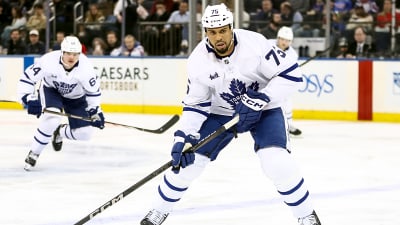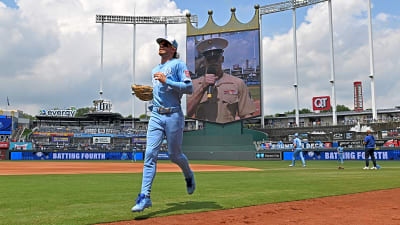The Edmonton Oilers were busy in the late rounds of this past NHL draft, with a trade that saw the Nashville Predators trade their 2025 fifth rounder to Edmonton in exchange for the Oilers 2026 fifth rounder. Let’s take a brief look at Asher Barnett, the player who the Oilers selected with that sixth-round pick.
Who is Asher Barnett?
| Position | Handedness | Height | Weight |
|---|---|---|---|
| LD | Left | 6’0” | 201 lbs |
The 2007-born defender hails from Wilmette, Illinois, USA. Barnett grew up playing within the Chicago Mission youth hockey program from the U13-U15 age group, leaving after the 2022–23 season to further develop as part of the US NTDP appearing for their U17, and U18 teams.
Barnett has also appeared internationally with team USA, at the U17 and U18 WJC levels. The left-shot defender even served as the captain of team USA this past year at the WJC U18 tournament.
Barnett’s on-ice production
Barnett is not known for his offensive production, so a quick glance at his point totals can be deceiving. The 6’0” defender is much more known for his steadfast defensive acumen, which led to his selection from Chicago Mission to the USNTDP. He averaged 18:19 of TOI this past season.
| Year | Draft Relative | League | Team | GP | G | A | P | Playoff GP | Playoff G | Playoff A |
Playoff P |
|---|---|---|---|---|---|---|---|---|---|---|---|
| 2022–23 | D-2 | U15 | Chicago Mission U15 | 15 | 5 | 6 | 11 | 5 | 1 | 4 | 5 |
| 2023–24 | D-1 | NTDP | US National Team U17 | 54 | 4 | 14 | 18 | ||||
| 2023–24 | D-1 | USHL | USNTDP Juniors | 35 | 0 | 6 | 6 | ||||
| 2023–24 | D-1 | WHC-U17 | USA U17 | 7 | 0 | 2 | 2 | ||||
| 2024–25 | D+0 | NTDP | US National Team U18 | 58 | 8 | 14 | 22 | ||||
| 2024–25 | D+0 | USHL | USNTDP Juniors | 21 | 3 | 3 | 6 | ||||
| 2024–25 | D+0 | WJC-18 | USA U18 | 7 | 2 | 4 | 6 |
The American is also committed to the University of Michigan for the 2026–27 season, so he has an extended developmental timeline. This extended timeline also means that he has a lot longer to figure out some of the offensive, and transitional elements to his game.
Barnett’s strengths
Barnett is a shutdown defender with some transitional breakout aptitude. The Americans game is highlighted by decent physicality, evident defensive senses, and solid gap control mitigation.
Physicality
In defensive transition and zone play Barnett uses his 6’0” frame quite well and this is exemplified through his relentless pursuit of quality body positioning, exertion of clean physical pressure, and overall grit.
In chances against off of the rush and in set zone plays, Barnett shows little hesitation for physical pressure exertion through quality tie ups, boxouts in the defensive slot, and board play that slows opponents pace down.
Barnett’s previously mentioned body positioning allows him to thrive in board battles as he consistently establishes new angles of attack, shows good puck protection elements along the boards, and shows elements of relentlessness.
On average Barnett involves himself in 12 puck battles a game with a high 58% win percentage in said battles.
In established zone plays the defender shows grit. This grit is articulated through a high shot block frequency of 1.41 per game. This blocking tendency reduces risky chances against too as Barnett shows decent poise in blocking lanes, and shots equally.
Barnett shows some inconsistency in compete level as there are games where he has a high motor, play engagement, and energy in all three zones, but they are not evident in every viewing.
Transitional play
The mass majority of Barnett’s game can be summarized as a gap control fiend who mitigates chances before they even present themselves. This is done in his defensive transition game which demonstrates quality space management, decent stick positioning, and evident defensive poise.
Through his space management Barnett shows an innate ability to implement pre-emptive scans which disrupts opposing team’s breakouts and often lead to his nine take aways a game. Alternatively this timing can reduce the effectiveness of an opponents rush game.
His tight gap control and space management that overpowers opponents to outside lanes and reduces the quality of their chances against is central to his shutdown nature.
Barnett often angles himself upon opponent zone entries that it pins the incoming forwards to the outside and reduces any chances against. This helps explain his 0.26 chances saved per game metric, and double downs on the importance of his body positioning as he gets inside positioning.
Another element that blends seamlessly with his gap is Barnett’s relentless pokechecks, stick lifts, and quality stick positioning. This stick usage not only hinders the rush ability of attackers, but this active stick remains evident in his sustained zone play as well.
Defensive poise is evident in his clean ability to handle two-on-ones when he is in position.
On the offensive side of the puck Barnett also shows some flashes of good option ID, okay vision, and pressure relief ability that does show some promise for the defender to be a breakout asset at the next level, pending some pass refinements.
Defensive senses
Barnett’s defensive game is best exemplified through notable defensive instincts, constant risk mitigation, and decent enough play anticipation. In the defensive zone the American rarely is not engaged in the play, which bodes well for his endurance, play reading, and lane awareness.
Barnett’s previously mentioned active stick is particularly evidence of this play reading and lane awareness in the defensive zone. The Oiler draftee also shows flashes of defensive awareness, particularly on his retrieval effectiveness that blend well with hints of quality pressure awareness.
He routinely mitigates the option creation of net crashing forwards with defensive pressure that simply makes it hard for opponents to play in front of him. This is also exemplified by the sheer fact that Barnett starts 67% of all of his shifts in the defensive zone, and enjoys 2:55 of penalty kill time per game.
There are moments that the fifth-rounder shows lapses in positioning and will randomly switch to man-on-man coverage, but within the next five years these positioning short comings are something thats should be worked out of his game. His defensive instincts are an attractive element of his game.
Barnett’s areas of improvement
Barnett remains a quite raw prospect. This is demonstrated through his ineffectiveness in the offensive zone, mixed efforts in puck skills, and skating short comings.
Offensive senses
To be blunt, Barnett is absent from most offensive plays. The defender shows severe limitations along the lines of offensive instincts, offensive awareness, effective playmaking/creation, and chance recognition. Barnett averages a mere 0.52 chances per game, and a 0.07 goals expected for rating.
These offensive metrics are not aided by a low shooting tendency of 2.7 per game with a 49% accuracy. The 131st pick’s offensive positioning also doesn’t help either, where he does have a habit of activating, at a frequency of 2.6 per game, but shows limited effectiveness in option creation upon those entries.
He often relegates himself to play support from the blueline, and shows some limited decision making.
Puck skills are evident barriers as well, as he displays telltale signs of handling, puck receptions, pass ability, and puck placement issues in transition. It’s a mixed bag of whether Barnett’s breakout will be an icing or a prelude to an offensive chance.
Skating projects to be just below average with an okay posture, but problems in terms of depth, rigid stride recovery, and inconsistent extension. These mechanical issues are then compounded by slightly below average skating power, acceleration ability, and separation speed.
These skating issues also further compound when Barnett’s sporadic positioning is considered.
The offensive senses, puck skills, and skating pose significant barriers to Barnett’s road to the NHL. The Oilers are taking a flyer on the defender, hoping that his long developmental path sorts some of these issues out.
Barnett’s next steps
The former Team USA captain looks to solidify his game at the junior ranks next season, which means a lot of refinements in terms of his overall game.
Then this time next year, the defender will be getting ready to join the ranks of the NCAA with one of the most prestigious programs out there, the University of Michigan. Four years there will help his development and growth significantly especially along the offensive elements of the game.
Barnett has a lot of time to become a breakout defender at multiple levels.
Projection with the Oilers
NHL ETA: 6+ years
Projection: seventh defender
There’s a lot to like about Barnett from his physicality, suffocating defence, and compete. At the same time the shut down defender remains quite raw and growth in decision making, positioning, and senses, and skating will go a long way.
How do you feel about this selection?
More must-reads:
- NHL's 2025-26 opening night slate is a showcase opportunity for the league
- Sabres, Bowen Byram avoid arbitration with new two-year deal
- The 'No. 1 overall MLB Draft picks' quiz
Breaking News
Trending News
Customize Your Newsletter
 +
+
Get the latest news and rumors, customized to your favorite sports and teams. Emailed daily. Always free!








